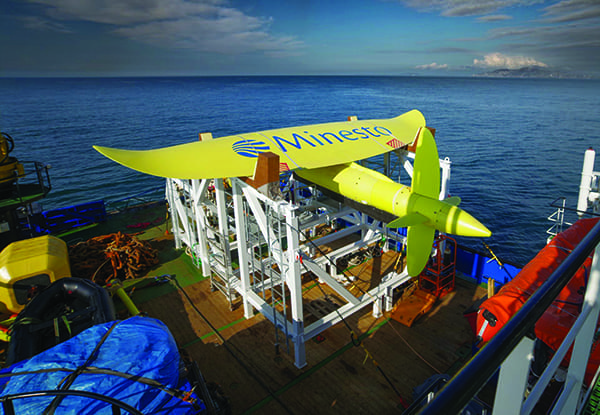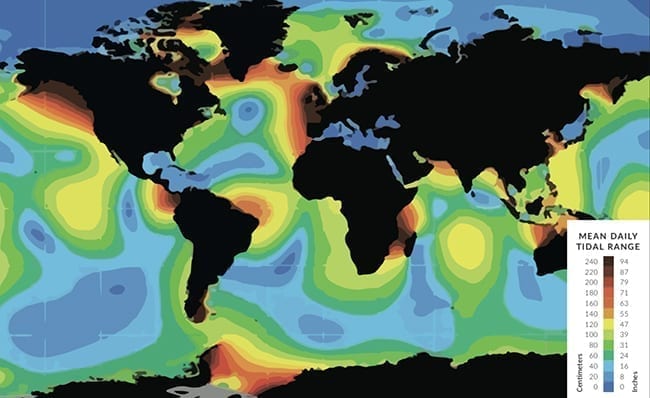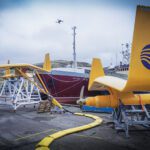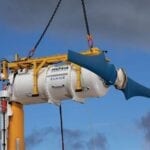At first view, marine energy developer Minesto’s novel underwater “kite” technology may be easily dismissed as a fanciful concept, one of dozens introduced over the last decade to reap the immense ocean power potential—but that would be a mistake. Since Minesto was spun off from Swedish aerospace manufacturer Saab in late 2006, the company has leveraged formidable private and public backing, and boosted the technology’s market readiness. Culminating these efforts—and making an immense splash for global marine power—the company in February secured a power purchase agreement (PPA) with Faroe Islands power entity SEV for 2.2 MW—a deal that comprises the planned installations of two grid-connected 100-kW Minesto Deep Green kites, as well as future utility-scale systems of at least 2 MW.
The deal is a big one for SEV, the main energy supplier for the Faroe Islands, an autonomous territory within the Kingdom of Denmark that comprises 18 islands in the middle of the North Atlantic Ocean (north of Scotland and halfway between Norway and Iceland). The entity, owned by municipal generators on those islands, today has 13 power plants for its population of about 51,000. In 2019, it produced nearly 57% of its total 380.4 GWh generation from oil, 28.2% from hydro, about 15% from wind, and a minuscule fraction from a 250-kW solar photovoltaic array installed in December. The territory, however, wants to phase out oil entirely by 2030, including for power, transport, and heating, owing mainly to volatile and often exorbitant costs for oil. Its long-term ambitions include a large-scale build-out of tidal energy of between 30 MW and 70 MW, making it a dominant and predictable energy source for the islands.
And for Minesto, the PPA opens an inroad into a niche, potentially lucrative renewables market: The exploitation of low-velocity (less than 2.5 meters per second [m/s]) ocean and tidal currents, which the company sees as a vast untapped global natural resource. “The marine energy sector is in the build-up phase, and Minesto’s strategy is to keep pace with the development of the value chain as the sector grows,” it said. That’s why, for now, Minesto’s business model is focused on multiple income streams: the core business, which consists of product sales, operation, service, and maintenance services; efforts to establish a market, which entails partnerships for large site development and joint demonstrations for smaller microgrid installations; and geographical licensing.
 |
|
1. Minesto’s Deep Green system converts kinetic energy in marine currents into power via a turbine mounted beneath a wing that is anchored to the seabed (or a surface platform) by a tether. The wing is subjected to the lifting force of the underwater current, which propels the system through the water. The power plant moves on a figure-eight trajectory, using a control system and rudder. As it moves across the current, the surrounding water flows through the turbine at a speed several times that of the actual current velocity. Courtesy: Minesto |
So far, the company’s only product is the Deep Green subsea kite, but it is a unique technology—and likely the only verified one in the world that can exploit low-flow marine streams cost-effectively. According to the company, the marine energy kite reaps power from low-flow tidal streams and ocean current streams—with velocities between 1.2 m/s and 3 m/s—through a “patented principle” that is similar to a stunt kite flying in the wind (Figure 1).
Because the underwater current creates a hydrodynamic lift force on the wing, it pushes the kite forward and ultimately steers it automatically in an “eight-shaped” trajectory, Minesto explains. As the kite “flies” across the current, it pushes the turbine through the water “at a speed several times faster than the actual flow rate,” a principle that essentially multiplies the stream flow through the turbine and enables efficient energy conversion in low-velocity marine currents. Power produced in the onboard generator is then transmitted to shore via a cable in the tether that is attached to the wing.
A Technological Readiness Leap
The design has quickly leaped to a technology readiness level (TRL) of 7, owing in part to notable support from private investors and public funding partners in the UK, Sweden, and the European Union (EU). After the first “QuappenKite” prototype was developed in 2007, proving that the kite could be steered on a predefined path, Minesto in 2009 produced the first electricity from the SeaKite I prototype in tank tests in the Netherlands, and quickly moved to ocean trials with the SeaKite II in 2011.
In 2013, it built the first Deep Green Ocean prototype with a 3-m wing span, and ran it at full tidal cycle at Queen’s University Belfast marine energy test site Strangford Lough in Northern Ireland. Finally, in June 2018, the company commissioned the first Deep Green utility-scale project at Holyhead Deep, a large depression in the seabed off the coast of Wales. The ongoing project comprises a single 500-kW demonstrator Minesto called “DG500.” Success of that project will allow the company to deploy a larger kite of between 750 kW and 1.5 MW.
That second-generation model of the “Deep Green Utility,” or DGU, will have a wing span of up to 24 m and be installed in water depths of 60 m or deeper (Figure 2). Bolstered with $15.6 million in EU funds, it is now seeking to install the newer DGU by 2021 to potentially expand the Welsh site to a commercial demonstration array of up to 10 MW—and ultimately, to scale it up into a commercial tidal energy array of up to 80 MW.

Meanwhile, Minesto is also developing the DG100, a 100-kW version of the second-generation Deep Green system for demonstration in microgrid applications, with installation depths of less than 60 m. Furnished with $3.6 million in public funding through the EU’s SME Instrument program and the Swedish Energy Agency, the first DG100 installation on SEV’s grid at Vestmannasund in the Faroe Islands is to begin early this year and the second will follow later in 2020, boosting its TRL to 8, the company said. The next stage in the Faroe Islands could entail the “incremental construction” of Minesto’s first large-scale production array of up to 30 MW, it said. Verification of the functionality and power generation with multiple units will propel its TRL to 9.
At the same time, armed with another $2.7 million in EU funding, development is ongoing on another project to install and commission a DG100 system at Paimpol-Bréhat, a test site connected to the French grid and operated by EDF off the coast of Brittany. Minesto is also part of a joint development project with the Center for Ocean Energy System at the National Taiwan Ocean University for a pilot installation in the tidal streams off Keelung, Taiwan, as well as an installation in the continuous ocean currents at the East Asian state’s Green Island. Minesto noted that project could open up a lucrative market opportunity in Southeast Asia, where the price of generated power is “less sensitive” and demand for renewables is high.
A Vast, Untapped, Niche Market
Still, as with other marine energy developers, power production costs rank high on the company’s list of future challenges—along with market acceptance, funding support, and permitting. Using methodologies that consider investments, operating costs, and decommissioning costs in relation to total energy yield during the lifecycle, the company suggests its levelized cost of energy (LCOE) could reach €100 ($111)/MWh after a cumulative 100 MW is installed in tidal streams, but in ocean currents, where plants could achieve a much higher capacity factor, the LCOE could drop to €50 ($56)/MWh at 100 MW cumulative installed capacity.
“This means that, at an early stage, the technology is expected to be more cost-effective than established forms of energy such as new nuclear power and existing offshore wind power,” it said. And that, it underscored, is “despite the fact that the company’s LCOE model does not take into account upscaling of the power plant’s rated power but is based solely on systems with an output of 750 kW. Moreover, the LCOE analysis is based only on production arrays with up to 75 MW installed capacity.”
Nonetheless, today the company is still highly dependent on subsidies. Since its founding, it has received a total $44.6 million from public agencies—mainly because it fits the bill for many state-driven initiatives, such as climate change mitigation, technological innovation, and for future industrial growth. Sweden, specifically, is backing it heavily, recognizing a role in the potential global export of the marine energy technology. The EU, meanwhile, is funding it through three separate initiatives, all related to boosting clean energy technology.
However, encouraged by global decarbonization efforts, Minesto is optimistic about its prospects. Though marine energy is still an emerging industry, it offers key advantages over other renewables, the company noted. For instance, it has no visual impact and a limited environmental impact.
The principle behind the technology, meanwhile, gives it several competitive advantages over other tidal energy technologies, which, though promising, appear to suffer lackluster investment support. One is that the system can be installed in deep ocean currents. Because these currents are constant and even, the prospect offers the potential to produce renewable baseload power.
The design is also small for its output. The DG500 prototype, for example, weighs 14 metric tons (mt), which compares to some competing tidal designs that weigh between 100 mt and 500 mt. Also, low-velocity marine current sites would be easier to access compared to strong flows, where other technologies can operate, giving the design an edge on costs associated with operations and maintenance.
Finally, and perhaps most significantly, the marine current market potential exceeds 600 GW—and that includes lakes, rivers, and oceans (Figure 3). That poses great opportunity, but it also comes with sizeable risk, because Deep Green’s commercialization is highly dependent on market confidence in the still “untried” industry. Because that confidence “may take time to realize,” it exposes Minesto’s technology to competition related to pricing, product quality, dependability, and financing terms.

“If marine electricity as an energy source cannot be successfully [commercialized], the company will not generate any income,” Minesto said. Yet, for now, the company is taking big steps to generate interest for the pioneering technology. Outside of its foothold in the Faroe Islands, Wales, the EU Atlantic Coast, and Taiwan, it is also “in dialogue” with established collaborations with research institutes and industry players in many of the world’s other markets, such as Japan, China, Canada, the U.S., Chile, Norway, South Korea, the Philippines, and Australia, it said.
—Sonal Patel is a POWER senior associate editor.










